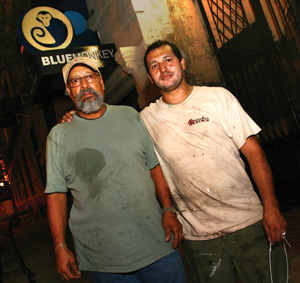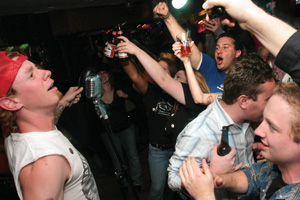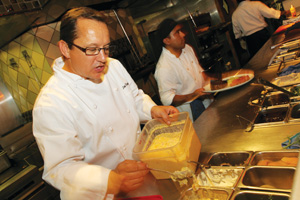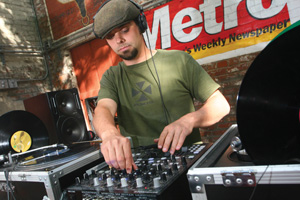SINCE OPENING its doors in 1958—more than a decade before the phrase “Silicon Valley” was coined or the microprocessor appeared and throughout the technology industry’s bubbles and bursts—Paolo’s restaurant in downtown San Jose has remained a dining destination.
As more than $2 billion was spent revitalizing the city’s core, Paolo’s moved from a small, gable-roofed, one-story wooden building at 12th and Santa Clara streets to the ground floor of a high-rise beside the Guadalupe Expressway. It has weathered downtown’s ups and downs, such as competition from Santana Row and the bankruptcies of San Jose Symphony and American Musical Theatre, both of which drew patrons for pre-show dining. Its location sheltered it from many of the problems with code enforcement and law enforcement and the patchwork of landlords waiting for big paydays that hampered businesses in nearby historic districts.
Throughout it all, the white-tablecloth restaurant managed to stay in business, offering an evolving menu of California-influenced regional Italian cuisine. Today, at the hand of maitre d’ and sommelier Jalil Samavarchian, Paolo’s offerings continue to combine the traditional with the contemporary.
Second-generation owner Carolyn Allen-Samavarchian credits a community philosophy with keeping diners returning. “We all understand and share the philosophy that we can, and will, rise or fall together,” Allen-Samavarchian says, “in spite of the challenges and limitations an economic recession imposes on a small business and its staff.
“This is not the first recession we have survived, and going through the ups and downs over 52 years has taught us a lot.” It’s no secret that the current recession has cut deeply into downtown San Jose’s nightclubs and restaurants, thinning the pack from the days of Ron Gonzales’ chaotic mayorship.
Over the years, many ventures have infused life into the downtown—the Fairmont, Convention Center, City Hall and HP Pavilion all became institutions of city life, while other efforts missed the mark. But, hey, that’s what happens when Silicon Valley–style entrepreneurship collides with “city planning.” Now, the San Jose City Council has begun to rethink many of its policies and attitudes toward downtown economic development. While falling short of reinvention, the new plan to boost the local economy seems to signal a more commerce-friendly approach to downtown’s battered businesses. Released last week, it aims to spark economic development and create jobs by offering new businesses incentives to locate downtown.
According to the proposal, the city and the Redevelopment Agency will offer perks like tax reimbursements and fee waivers to pump some life into the city’s central district.
“I’m not trying to oversell this thing as the savior, because it’s not,” says Councilman Sam Liccardo, who represents the downtown district. “City Hall isn’t going to save anything. I think what we can hope for is that we’re going to make an incremental difference. I’m not putting out the messiah plan, I’m putting out a program change and thinking about the relationship between the city and the business community.”
New School of Thought
As a professor of urban and regional planning at the Institute for Metropolitan Studies at San Jose State University, professor Dayana Salazar says that the issues that San Jose faces are not unique.
“This is something that San Jose and many cities in the United States have struggled with for years,” Salazar says. “They are seeing a major exodus of businesses. San Jose has been working to bring viable, vibrant retail to downtown since the ’70s, pretty much, with varying degrees of success.”
Salazar points out that downtown San Jose has made progress—much of it in the past couple of decades.
“It’s a very different place then it was when I came to San Jose State back in 1991,” she says, “when basically, if you were to spend any time here after 5pm or 6pm, you’d be pretty much on your own.
“Today, it’s a very different story. The core of downtown San Jose has definitely seen a great deal of infill development. Areas that were vacant now have businesses, and most of these buildings now have ground-level retailers and are in some kind of an active use, vs. simply being parking lots.”
Still, longtime downtown business owners have their own ideas of what the area requires in order to prosper. For many, the key to survival lies in creating a sense of community on all levels: working together with City Hall, small and big businesses, community groups and every member of the public. For Carolyn Allen-Samavarchian, improving the mood and aesthetic character will count for a lot.
“We need an atmosphere which attracts and makes visiting, working and residential living downtown safe, convenient and desirable,” she says. She cites other oft-mentioned examples of conventional wisdom that have yet to get traction: “A more pedestrian-centric, urban-friendly feel; sidewalk cafes with street-side tables; diverse retail stores and boutiques with a few national anchors; more art, galleries and museums, theater and concerts; an upgraded and enlarged convention center.”
Brad Goldberg, managing partner at the newish downtown eatery Billy Berk’s, says San Jose needs to play up its high-tech connection.
“I think about other major cities I’ve been to, and they all have a significant piece that they’re known for—the ocean or the Space Needle or coffee in Seattle, or beer in Portland,” he says. “I think about San Jose, and what’s our claim to fame? It’s technology, computers and innovation. It’s something to be proud of, and I don’t know that we’ve promoted it.”
He says the city also needs more sports teams. “I can tell you this, the Sharks breathe life into this city,” he says. “The relationship that San Jose has with the Sharks is unique. This is how I imagine cities like Pittsburgh feel about the Steelers or how Boston feels about the Red Sox.
“If the city could get more of that—maybe if we could get the ‘Niners, not to San Jose but close enough, and if we can get the A’s—it would be fantastic. I mean, it’s a big deal in a city of a million people to have just one sports franchise, and the powers that be know it and they’re working on it.”
He imagines the impact an A’s move would have on downtown and does the math comparing baseball to hockey: “You’re talking 81 games of 40,000 people, vs. 40 games with 18,000 people. I mean, can you imagine? That’s a huge, huge difference.”
Where’s the Hype?
Ben Soriano, owner of South First Billiards and vice president of the San Jose Downtown Association, thinks that what is needed is an intense public relations campaign to promote downtown, along with more redevelopment money going to already established small businesses for things like facade improvements.
“To me, it’s an issue of doing the marketing that needs to be done to really reflect what has been going on in downtown for these past few years,” Soriano says. “I don’t think the public at large understands that there is a thriving community downtown. That it’s not only a nightclub scene but that there are people of all generations who enjoy what goes on downtown, and not just special-event nights but constantly.
“More needs to be done to be that 800-pound gorilla that we are, because, our reputation, as I see it today, does not reflect the vibrancy and activity that is going on downtown.”
Roger Springall, owner of Caffé Trieste, sees San Jose’s empty high-rise apartment buildings as the city’s biggest hurdle to success.
“I moved to San Jose in 1986, and I lived in the Almaden Valley. I took one look downtown and it was horrible, and I never came back,” Springall says. “And a lot of people will say the same thing. Then, three years ago, when I was looking to open up Trieste, I decided to take a look downtown, and I thought, ‘Oh wow, it’s really changed.’
“But the economy is so slow, it’s like walking through quicksand. I just need more people, more people living and working downtown, but especially living downtown.”
Springall says that a big reason why his business continues to survive in the midst of the biggest economic slump since the Great Depression is that Caffé Trieste offers all-ages entertainment, including bands, poets and even opera.
Another bean grinder, Nick Taptelis of Philz Coffee, has helped energize the pedestrian-friendly Paseo de San Antonio near San Jose State with coffee strong enough to defibrillate a cardiac patient. The San Francisco–based operation chose downtown over competing locations because “it just felt right.” The cafe draws a cultlike, diverse crowd that ranges from students and open-mic poets with rivets and disks in their ear lobes to businessmen in suits and firefighters who park their engines in the red zone.
Despite the promises of the two most recent mayors to cut red tape, Taptelis sings a common refrain about the permit process. “The city gave me a hard time about opening up,” he says with a shrug.
Taptelis dealt with it the same way he makes drip coffee—”time and patience” and take it in stride. Business gets better every day, he says. “I feel like 10 years from now this city will be popping. There’s a lot of potential here.”
Salazar says that success will come down to getting more warm bodies out and about on the street. To do that, she says, the city also needs to change perceptions.
“It’s really the chariot-and-horse combination, where to some extent you need retail and business to attract people to come downtown,” she says, “but you also need the people to patronize the retail and the entertainment places and the restaurants. If we have that resident population in downtown, retail will come after.”
Because the city has seen numerous plans and strategies come and go over the years, many in the business community question if City Hall’s current effort will actually achieve its aim to “plant the seeds of San Jose’s economic resurgence.”
“I think it’s a good start, but much more needs to be done,” Allen-Samavarchian says. “Expediting permitting is not enough. The approval process is an expensive and convoluted nightmare, especially for small businesses that cannot afford to hire consultants to navigate it for them. It simply should not be that way.”
For his part, Liccardo gets that. “There have been a lot of false starts downtown,” he says. “What I find to be most frequently the cause of those false starts is that we’ve had some wrong-headed approaches to how core urban areas develop organically. We’ve had approaches in the past which have focused on subsidizing large chain stores and chain restaurants. We’ve had periods where we discouraged high-rise residential development and would only insist on offices.
“I think the lesson we’ve all learned is that you have to allow development and business to grow organically in the downtown, and you can’t be choking it with regulations and interventions.”
These new incentives are about getting the ball rolling and not just waiting around for a good business environment to happen magically.
“I think we’ve got a core group of uniquely creative, committed people downtown, who have weathered a lot of storms financially but continue to want to create a vibrant urban center here,” he says. “I can’t help but believe that when the conditions finally do return for growth opportunities, that we are going to be in a great position to finally take off. We’ve learned a lot of tough lessons over many years, but I think the stage is really well set now.”
Downtown Down a timeline
The city of San Jose’s newest stimulus plan to revitalize downtown follows a two-year stretch when a dozen landmark nightclubs perished.
9-2007 – Naked Ape
Blue Monkey Lounge
Date Opened: July 2004
Date Closed: September 2007
Owner: Mondo Millan
Official reason for closure: Room capacity/issues
Notorious for its punch-packing Monkey Kiss cocktail, the Blue Monkey offered a funky, mature twist on the upscale martini lounge. Longtime downtown bar owner and operator Johnny Van Wyk says that capacity issues with the city ultimately became the straw that broke the Monkey’s back. The owners, meanwhile, have opened an eatery in downtown Campbell, where nightlife is hopping and city officials are more tolerant. The former lounge location at 1 E. San Fernando St. is now the home of the Hanuman Thai Restaurant.
4-2008 – Out of Flavor
Taste Ultra Lounge
Date Opened: Late 2006
Date Closed: April 26, 2008
Owners: Isaac Barrera and Carlos Carmona
Official reason for closure: Lease terminated
On the still-alive MySpace page for the now-defunct Taste, former owner Isaac Barrera posted a 1,775-word manifesto detailing his club’s demise, including a play-by-play of all their legal troubles with their landlord and the building’s owners.
“Carlos and I put everything we owned and every penny we had to build a business … but because some man decides he doesn’t want nightlife in San Jose or doesn’t like our clientele, we lose everything we invested,” Barrera wrote. Barrera and Carmona now operate a Taste Ultra Lounge in Stockton and fill buses with San Joseans who want to party there. Who ever thought that would happen?
4-2009 – The Chameleon
Vivid/Pearl Nightclub
Date opened as Vivid: February 2007
Date closed: April 26, 2009
Date Reopened as Pearl: May 15, 2009
Owner: Jenny Wolfes
Official reason for closure: Remodel
Pearl, a.k.a. Vivid, a.k.a. Studio 8: a club by any other name … is still the same. Every two years or so, operator Jenny Wolfes closes this high-ceilinged nightclub at 8 S. First St. She revamps it, and the name is changed, yet the final product still remains familiar. Vivid was Studio 8 with a new stage and some video screens, while Pearl is Vivid with some new furniture and curtains, walls of flat panel monitors and some mood lighting.
5-2009 – Hammered
Johnny V’s
Date Opened: Feb. 24, 2002
Date Closed: May 31, 2009
Owner: Johnny Van Wyk
Official reason for closure:
It’s complicated.
Van Wyk says that his building’s owners wanted to raise his rent. He also blames aggressive policing by SJPD for driving away his clientele.
This local favorite dive bar was known for having good bands and cheap drinks served with a heavy hand. It was originally two levels with a 248-person capacity, but that was whittled down to 48 as the cost of rent went up.
“I want to open another bar,” says Van Wyk, who is currently painting houses to pay off his leftover debt. “It’s what I do, and I’ve been doing it in San Jose since 1993. But at this point it’s frightening, the city environment. I had points where I had four or five entertainment police coming into my operation two to three times a week doing checks and going through all my stuff, like I was some kind of criminal.
“They contradict themselves because they claim they want to be a 24-hour city; they claim that they want big city nightlife, yet they make it impossible for guys like me. The city of San Jose, to put it frankly, really screwed me.”
5-2009 – A Cold One
Tied House
Date opened: 1991
Date closed: May 4, 2009
Owner: Peter Licht
Official reason for closure: The economy went kaput.
This Sharks fans’ staple was always jumping when the Tank was full; but the huge, hangarlike space at 65 N. San Pedro St. was a ghost town much of the time. Though the food was never the big draw, the Tied House was a downtown San Jose brewpub that boasted eight tasty microbrews, along with seasonal offerings. When it closed up shop, Licht said he was planning to open a production brewery called the Hermitage at the corner of Virginia and South First streets. As far as we can tell, nothing has come to fruition with that yet.
6-2009 – Invincible?
Vault Ultra Lounge
Date opened: May 2004
Impending Closure Announced*: June 27, 2009*
Owner: Group including Mauricio Mejia and Harry Evans
Official (stated) reason for closure: Agency enforcements, partnership difficulties
*NOTE: As of this writing, despite published reports to the contrary, the Vault remains open.
Vault was the first club in San Jose to strike gold with the “ultralounge” concept. For years, it was a challenge to even get in the doors of this posh, two-level club located in a converted savings-and-loan building on West Santa Clara Street, just for all the bodies packed in there every weekend.
On June 27 of last year, Vault held a “5-Year Anniversary and Grand Finale.” A flier announced that “closing the last night of Vault [are] DJ Raheem and DJ Remedy.” Metro heard back in June that after the close they were undergoing a “massive renovation” and would reopen in August as “The Republic.” Then for a moment, the name was “Area 81.” However, almost six months later, the doors are still open for business every weekend, and banners that say “Vault” still hang proudly from its stone facade.
7-2009 – Dead Meat
A.P. Stump’s Chop House
Date Opened: Summer of 1998
Date Closed: July 10, 2009
Owner: Andy Pavicich III and chef Jim Stump
Official reason for closure: Bad economy
A longtime favorite hangout for San Jose’s well dressed old money crowd, New American restaurant turned chop house A.P. Stump’s boasted some of the city’s most expensive privately funded tenant improvements. It opened back in the heyday of the dotcom boom and closed in the middle of the global recession 11 years later.
7-2009 – Musical Chairs
Club Wet
Date opened: Oct. 25, 2008
Date temporarily shuttered by SJPD: July 8, 2009
Owner: Mike Hamod
Official reason for month-long closure: Stabbing incident and excessive dance floor movements documented on YouTube
The SJPD greeted the opening of Wet (formerly Polly Esther’s, Cabana and Glo) by barricading one block of South First Street and videotaping everyone in line. Still, the huge nightlife spot located in a former theater space at 396 S. First St. has managed to remain packed, effectively sucking business from every other large dance club in the downtown. Wet frequently flies in celebrities and DJs from Las Vegas, Los Angeles, New York, Miami and Dubai in an attempt to put San Jose on the international club map, something that city leaders have failed to sufficiently appreciate.
10-2-2009 – Mission Impossible
Mission Ale House
Date opened: Feb. 29, 1996
Date closed: Oct. 28, 2009
Owner: Dan Doherty
Official reason for closure: Economy, problems with city/police, and owner wanted to get out of bar business
Once nicknamed the “Mission Male House” for its gender imbalance, Mission Ale House was a longtime downtown San Jose fixture (‘Niners quarterback Jeff Garcia drank his way to a DUI there).
Fourteen years and numerous problems with the police and city regulations later, owner Dan Doherty sold the place to local Freddy Jackson this fall. After a lightning-fast remodel, a canvas “Freddy J’s” sign was slapped up and the place is currently back in business. Jackson has been trying to go upmarket with the 97 E. Santa Clara St. location, one of the closest watering holes to the new City Hall.
10-2009 – Murky Water
Splash
Date opened: 2004
Date closed: Oct.1, 2009
Owner: T.J. Bruce
Official reason for closure: New owner and extensive renovations
Once one of San Jose’s most fabulous gay dance clubs, Splash was bought by T.J. Bruce, owner of the Badlands gay nightclub in Sacramento, last October. The spot at 65 Post St. was then closed to bring it up to code, but renovations to the building, once a 19th-century brothel, are taking longer than expected. After they’ve waded through all the red tape, Bruce says they’ll open the bar this spring complete with a new name, new plasma screens and a new live VJ.
11.2009 – No More Sugar?
Azucar Latin Bistro & Mojito Bar
Date opened: Late 2006
Date name changed: Late 2009
Owner: Geo Belaski
Official reason for name change: Unknown
We’re not sure why this popular Latin bistro decided to change their name to Diablos. In late 2009, a haphazard neon sign reading “Diablos” replaced one side of the longtime Azucar sign out in front of this lounge known for its solid tropical-infused menu and salsa dancing. Seems to us that if a place is famous for its plethora of saccharine mojitos and pomegranate-infused tequila, the former title would be more fitting. Alas, it still seems about the same, besides the addition of a few plush booths to make it seem more clubby. Metro was unable to reach owner Geo Belaski for comment.
12-2009 – Smoked Out
Smoke Tiki Lounge
Date opened: Dec. 1, 2005
Date closed: Dec. 31, 2009
Owner: Dan Doherty
Official reason for closure: Financial problems, flagging business and change of concept
Current operator Tim Littlefield (former co-owner of the now-defunct SoFA Lounge) says that he’s closing Smoke in order to turn it into an upscale “comfort food” eatery. He also wants the location formerly known as Smoke to lose its nightlife reputation.
12-2009 – The Lazarus Room
Spiedo Ristorante
Date opened: 1994
Date rebranded to Agave Viejo: May 1, 2009
Date Changed back to Spiedo: Dec. 2009
Owner: Hamdi Bogart Ugur
Official reason for rebranding to Agave Viejo: Owner wanted to do a “duel concept” eatery.
Owner Hamdi Bogart Ugur switched longtime downtown Italian restaurant Spiedo into a “dual concept” eatery. For a brief few months, they had a tequila bar and served Mexican food under the name Agave Viejo, all the while still offering Italian food under the name Spiedo. Shockingly, the idea didn’t rake in the gold, and the space at 151 W. Santa Clara St. is now back to being named Spiedo. Oddly, it now serves a completely different menu of American fusion cuisine—but has kept the tequila bar. Spiedo in San Mateo still serves Italian food, however.








